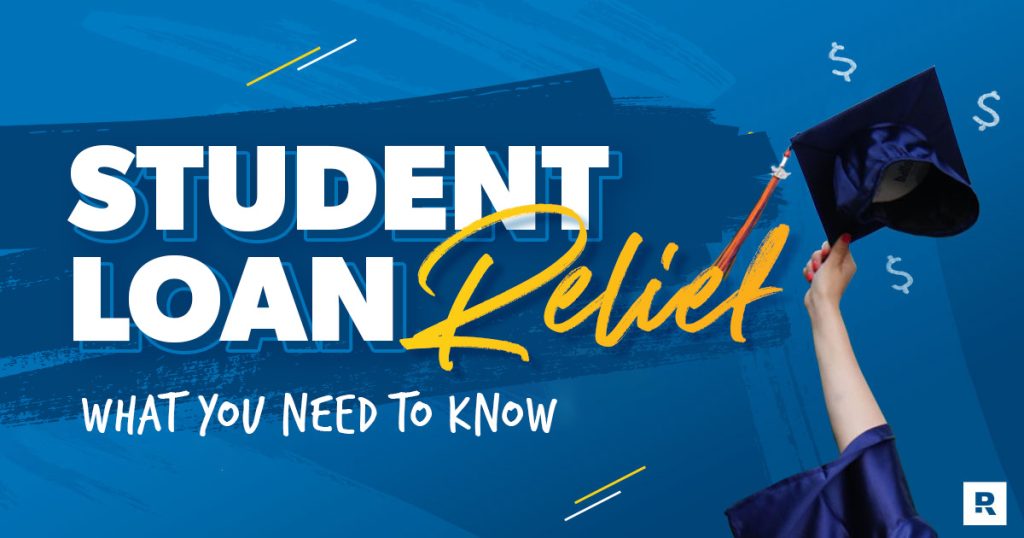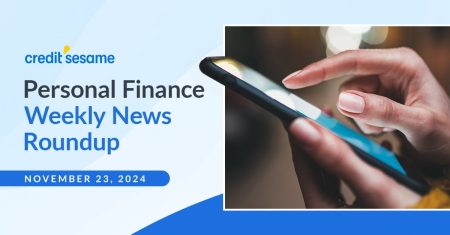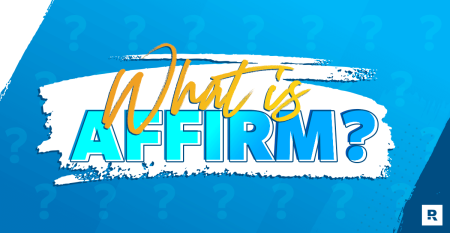Update as of June 2023: Federal student loan payments will resume October 2023—with interest starting back September 1, 2023.
Unless you’ve got a crystal ball, you probably never would have guessed how crazy things would get over the past few years. It’s been a whirlwind of change for sure! And for people who have been severely impacted by the COVID-19 pandemic and inflation, “whirlwind” is the understatement of the century.
One of the ways the federal government has been trying to calm the lasting storm is through financial relief programs. And if you’re one of the 43 million people with federal student loans out there, you might have gotten some temporary relief on your student loan payments through the CARES Act that was passed in March 2020.1
Since then, there have been several student loan relief extensions. Most recently, the president made an executive order to extend the emergency student loan forbearance yet again through no later than June 30, 2023—or until the legality around his student loan forgiveness plan is settled.2
We’ll get into the details of the most recent extension in a minute. But first, here’s a quick refresher of how this whole payment pause came to be.
What Is the CARES Act?
Let’s flash back to March 2020 for a minute (don’t worry, we won’t stay here long—it’s just to get some context). COVID-19 was just beginning to pick up steam in the United States and cases were rising across the country. In just a matter of weeks, millions of people suddenly found themselves jobless as businesses buckled. In order to help Americans and stimulate the economy, Congress passed the $2.2 trillion Coronavirus Aid, Relief, and Economic Security Act (aka the CARES Act).
The CARES Act wasn’t perfect, but it attempted to help Americans with federally owned student loans by offering:
- Temporary payment suspension
- A 0% interest rate
- A pause on all collections and wage garnishments on defaulted loans
Just to be clear, the CARES Act is separate from President Biden’s recent student loan forgiveness plan (though the two have become more tangled than a pair of earphones in your pocket, as we’ll talk about in a minute). The CARES Act itself doesn’t forgive student loans—it only offers temporary relief from student loan payments and interest.
The CARES Act was set to expire on September 30, 2020. But as the pandemic continued and the economy had more ups and downs than a Ferris wheel, the CARES Act has been extended multiple times since then. Let’s take a look at the latest student loan relief extension and what it means for you.
The Latest Student Loan Relief Extension
Up until now, the student loan relief extensions were mostly based on how the economy was doing (i.e., not great). But this latest student loan payment pause extension (announced in November 2022) is for a whole other reason.
President Biden was all set to have federal student loan payments start back up in January 2023, but he was also counting on his student loan forgiveness plan to have gone through by then—which hasn’t happened yet.
In fact, there’s been several legal challenges to Biden’s plan, and court orders have temporarily blocked the forgiveness until further notice. With so many borrowers waiting to find out if they’ll even have student loans to pay off in 2023, Biden made the call to extend the payment pause until things are sorted out. That could either mean the forgiveness is approved or it’s shot down completely. Either way, once a decision is made, federal student loan payments will resume 60 days after that.
Ready to get rid of your student loans once and for all? Get our guide.
When will we get an answer? No one really knows. But if there’s no decision by June 30, 2023, federal student loan payments will resume 60 days after—so, around September 2023.3
What the Student Loan Payment Relief Extension Means for Your Student Loans
We know the most recent extension is a little confusing, and there’s a lot riding on what happens with Biden’s student loan debt relief plan. Repayment of all federally owned student loans is still on pause, and the interest rate will remain at 0%.
This includes Direct Stafford Loans, Direct PLUS Loans for parents and graduate students, and Direct Consolidation Loans. It also covers Federal Perkins Loans and Federal Family Education Loan (FFEL) Program loans if they aren’t commercially owned.
Like the original piece of the CARES Act, all borrowers with federally owned student loans are automatically included in the extension. That means you don’t have to sign up or do anything to keep having your payments or interest waived. In fact, if you want to keep making payments (which you should if you can), you’ll need to call your loan servicer or go online to manually make a payment.
Navigating student loan repayment can be a total maze even in less insane times, but right now, it’s more confusing than ever. So, let’s take a look at how the student loan payment relief extension plays out in certain circumstances—as well as some other changes that have been made along the way.
Loans That Are in Default
If you were in default on your student loans before the pandemic—meaning you were behind on payments—there may be some good news for you.
President Biden announced a “fresh start” initiative in April 2022 that gives borrowers in default or delinquency on their federal student loans a chance to start the repayment process back in good standing.4 It’s still not clear what steps people will need to take to actually make this happen, so stay tuned for more news from the Department of Education.
But here’s the deal: If your student loans were in default before, you’ll probably have trouble paying them again when student loan relief ends.
That means now’s your chance to get on top of your student loans! With payments on pause, no interest, and no wage garnishments or collections on federally owned student loans right now, it’s the perfect time to make progress.
But maybe COVID-19 has meant your hard times have gotten harder. The student loan relief extension might be giving you just enough breathing room to keep paying your rent or keep food on the table. If this is your situation, it’s important to get in touch with your loan servicer as soon as possible to discuss a plan for what your payments will look like when the pause ends—because it will end.
And speaking of plans, if you’ve been putting off making (and sticking to) a budget, there’s no time like the present. If there’s one thing that can take some of the sting out of a stressful time, it’s having a plan for your money. We’ve got a great free tool to help you get started.
Public Service Loan Forgiveness
Right now, paused payments still count toward the Public Service Loan Forgiveness (PSLF) program, as long as you’re still working full time for an eligible employer and meet all the other requirements.5
Real talk: The PSLF program has more hoops and hurdles than a horse show. But if you’re still trying to qualify, check in with your loan servicer to make sure you’re still checking all the right boxes the program requires. Just don’t bank on this as the answer to your problems. Because with less than 2% of people actually getting approved for PSLF, you do not want to put all your eggs in the student loan forgiveness basket.6
And if you’re in a position to keep paying on your student loans, do it. Take advantage of 0% interest and attack your principal. Show it no mercy! The sooner you’re out of debt, the sooner your money belongs to you.
Private Student Loans
If you have private student loans, you’re probably well aware by now that the CARES Act did not include any relief for private student loan borrowers. And sorry—this new extension doesn’t either.
It’s highly unlikely that any bank or private lender is going to proactively do anything to help you with your loans—after all, they’re in the business to make money. But if your finances have taken a major hit during this time, you’re going to have to pick up the phone, call your loan servicer, and ask if they’ll pause your payments for a period of time or reduce your payment amount. It may not happen, but it’s worth a shot.
But just like with federal student loans, if you’re in a position to keep paying on your private loans, then keep at it. You can also look into refinancing your private student loans to get a better interest rate. And even if you have to scale back temporarily, don’t lose steam at crushing your debt. You deserve to get those student loans out of your life!
Commercially Held Federal Student Loans
The new student loan payment relief extension only applies to federally owned student loans. That means no commercially owned FFEL Program loans or Perkins loans are eligible. (If you have a federally owned FFEL or Perkins loan, then you’re good.)
What to Do With Your Student Loans
Money stress is terrible. It creeps into every second of every day, robbing you of your peace of mind. This global pandemic may have really pulled the rug out from under you in a big way. Or maybe you’d just rather not think about your debt if you don’t have to right now. Hey, we totally get it.
But that doesn’t mean you should bury your head in the sand and wait for your student loans to magically disappear. In fact, the more you lean into a plan of action that includes making and sticking to a budget, the more control you’re going to get back. Trust us, your intentionality will be a lifesaver.
So, no matter how the pandemic has affected your finances, you can still work toward your goal to knock out your student loan debt for good. The timeline might look a little different than you expected, but stay the course. You’ve got this!
Here’s what to do right now about your student loans, depending on your situation.
If Your Income Is Stable
If your income is stable, you’ve got a couple of really good options available to you. The first is to keep on keepin’ on—that is, keep paying your student loan payments each month. That may sound crazy, but hear us out: With 0% interest on federally owned student loans, your entire payment goes directly toward your principal. Heck yes! You’re paying those bad boys down faster than ever. And you’ll pay way less interest in the long run!
Your second option (if you’ve got other debts besides student loans) is to use student loan relief to throw even more money at your other debts. With the debt snowball method, you pay your debts down from smallest to largest. But while student loan payments are paused, you can choose to take your monthly student loan payment and use it to knock out your other smaller debts faster.
But here’s the deal: If you go with the second option, you must keep a debt-attacking mindset. Yes, your student loans are paused for several more months, but they aren’t gone! Take advantage of this time to wipe out your smaller debts and then immediately return to paying off your student loans.
And don’t forget: Because your student loan payments have been automatically paused, you’ve got to be proactive about making a payment each month. Sure, it’s a little bit of a hassle, but you’ll be so glad you didn’t let up once student loan relief ends and everyone else is feeling the pain of payments again.
If Your Income Is at Risk
So, what if things aren’t so stable right now? Maybe you lost your job, maybe you’ve got an immediate family member with a serious illness, or maybe you’ve got a baby on the way—whatever the case may be, don’t let financial uncertainty derail you. If you’ve lost some or all of your income or you know your expenses are going to change in a big way, your job is to stockpile money.
Your priority right now is making sure your Four Walls—food, utilities, shelter and transportation—are taken care of. And if you don’t have an emergency fund of $1,000, get that as fast as you can.
If you can keep paying your minimum payments on your debts, do it. Right now, your minimum federal student loan payment is technically zero—and there’s no penalty if you don’t pay. So, while it’s best to keep paying on your student loans if you can, if you’re really in a pinch and worried about covering the basic necessities, hit pause on your federal student loan payments and save that money to get through this season.
And if you have private student loans, call your loan servicer ASAP and explain your situation. Ask if they’ll pause your payments or work with you on a reduced payment plan. You might also want to get connected with a financial coach who can walk you through your specific situation and give you a plan to get back on your feet.
But remember, this isn’t a forever situation. Stay calm and stick to the plan. As soon as your income goes back up, resume attack mode on that debt.
Should You Consolidate Your Student Loans?
Got more than one federal student loan? Consolidating your student loans could help you pay them off faster. But it’s not the right choice for everyone.
If you’ve got multiple loans, especially ones with variable interest rates, consolidating them can help by giving you only one payment and a fixed rate to keep up with. But you might make more progress plowing through each individual loan one at a time, rather than trying to chip away at one massive loan. It’s less about the math and more about the momentum.
Even if you choose to consolidate your loans, don’t let off the gas! You should still aim to pay more than your minimum monthly payment to knock out your student loans as fast as you can.
Should You Refinance Your Student Loans?
While the CARES Act and the student loan payment relief extension can help you catch your breath—and maybe even get ahead—on your federal student loans, what about your private student loans? Well, one thing you can do to help you gain traction is to refinance your student loans.
But refinancing isn’t for everyone. You should only refinance your student loans if:
- It won’t cost you anything to refinance them
- You can get a fixed interest rate instead of a variable rate
- Your new net interest rate is lower than your current net interest rate
- You don’t sign up for a longer repayment period
- You don’t get so relieved by the thought of a single payment that you lose your motivation to pay off your debt fast
And you may hear that you can combine your federal and private student loans by refinancing them together, but don’t do it! If you do, you won’t qualify for any student loan forgiveness under Biden’s plan or any existing forgiveness program.
Bottom line: Refinancing isn’t the only solution, but it can be the push you need to kick your debt payoff into high gear.
How to Get Rid of Your Student Loan Debt
Yeah, the student loan payment pause may be a nice relief. But an extension is not an excuse to completely abandon your plans to be debt-free. Don’t wait until the new year rolls around to come up with a payoff strategy. Do it now. As in today.
You may get some relief from Biden’s new forgiveness plan (if it ever does happen). But relying on the government to figure out a solution for the rest of your student loans is a recipe for disappointment. Instead, you can take control of your money and your future.
If you’re financially able to continue attacking your student loan debt, then don’t slow down now. You’ve got some great opportunities to make the extension work even harder for you. But if you’re just getting started or you’ve been forced to slow down your debt snowball, it’s time to get focused.
Start with a budget. Telling your money where to go in advance gives you the power to cover the basics and make your student loan payments—instead of just hoping you’ll have enough. Plus, you can adjust your budget to throw even more at your loans so you can get them out of your life faster!
Go ahead and start budgeting for your student loan payments today!
Read the full article here










